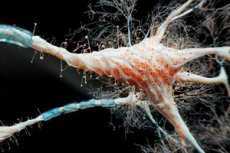New publications
Some nerve cells trigger inflammation on purpose
Last reviewed: 02.07.2025

All iLive content is medically reviewed or fact checked to ensure as much factual accuracy as possible.
We have strict sourcing guidelines and only link to reputable media sites, academic research institutions and, whenever possible, medically peer reviewed studies. Note that the numbers in parentheses ([1], [2], etc.) are clickable links to these studies.
If you feel that any of our content is inaccurate, out-of-date, or otherwise questionable, please select it and press Ctrl + Enter.

Individual brain nerve cells activate immune proteins to fix certain unpleasant events in memory.
Memory formation is associated with the transformation of nerve cell networks. Some connections between neurons are strengthened, others are born, and some disappear. Transformations are accompanied by intensive changes in the gene and molecular apparatus. Often, scientists discover one or another gene or protein substance that participates in the formation of memory and retains information. However, the entire molecular-genetic mechanism of memory support remains a mystery to us.
In their recent work, the scientists described a group of nerve cells located in the hippocampus. The mechanism of these structures became relatively clear: after special DNA damage, inflammatory processes were triggered in them.
Representatives of the A. Einstein School of Medicine conducted an experiment on rodents: under certain conditions, a weak electric shock was sent to their paws, activating the method of remembering unpleasant events. Then, if the rodent was again placed in the cage in which it experienced the electric shock, the animal froze in alarm, demonstrating a stress reaction. According to scientists, in certain nerve cells of the hippocampus after stress exposure, an inflammatory reaction is formed, caused by a connection with the protein agent TLR9, or toll-like receptors.
This type of receptors belongs to the class of innate immune protection: they demonstrate a reaction to manifestations typical of large pathogenic groups. In the presence of a threat, these receptors initiate certain processes within the cellular structure and inform neighboring cells and the immune system about the problem that has arisen.
In ordinary hippocampal nerve cells, memory genes are quickly switched on after DNA damage. The TLR9 protein is needed to ensure that the necessary information is stored in memory: when this protein was switched off, the rodents did not remember an unpleasant situation for a long time - in particular, the stress they experienced when exposed to electric current.
How does TLR9 get turned on? DNA appeared in the cytoplasm of nerve cells, placed in special membrane bubbles. Active TLR9 started the DNA repair process: at the same time, a whole series of regulatory proteins appeared, and DNA particles were grouped at the cell organelle - the centrosome. Thus, DNA particles indicating genome damage, together with TLR9 and other protein substances, started DNA restoration in the cell nucleus. This entire process pursued only one goal - the formation of long-term memory.
Despite the fact that TLR9 is an immune protein associated with an inflammatory response, there is no inflammatory process in the full sense of the word: nerve cells continue to function and exist normally. All that is used are two similar mechanisms of immunity and neural memory, which have the same molecular set of tools. It is quite possible that there are still differences at some stages. However, scientists will have to study these issues in subsequent studies.
Details on the Nature journal page
